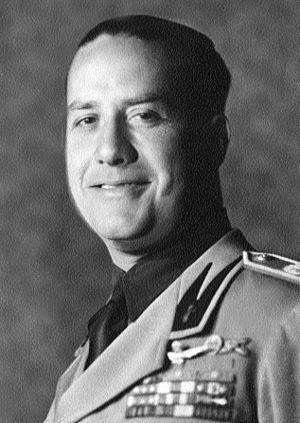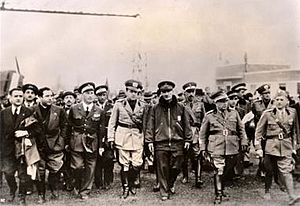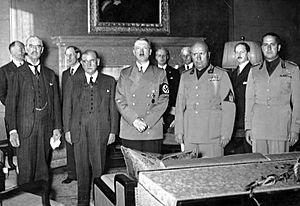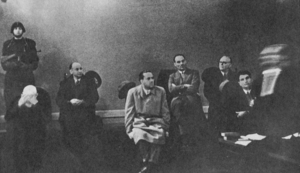Galeazzo Ciano facts for kids
Quick facts for kids
Galeazzo Ciano
|
|
|---|---|

Ciano in 1936
|
|
| Ambassador of Italy to Vatican City | |
| In office 5 February 1943 – 25 July 1943 |
|
| Preceded by | Raffaele Guariglia |
| Succeeded by | Francesco Babuscio Rizzo |
| Minister of Foreign Affairs | |
| In office 9 June 1936 – 6 February 1943 |
|
| Prime Minister | Benito Mussolini |
| Preceded by | Benito Mussolini |
| Succeeded by | Benito Mussolini |
| Minister of Press and Propaganda | |
| In office 23 June 1935 – 11 June 1936 |
|
| Prime Minister | Benito Mussolini |
| Preceded by | Position established |
| Succeeded by | Dino Alfieri |
| Personal details | |
| Born |
Gian Galeazzo Ciano
18 March 1903 Livorno, Tuscany, Kingdom of Italy |
| Died | 11 January 1944 (aged 40) Verona, Italian Social Republic |
| Cause of death | Execution by firing squad |
| Political party | National Fascist Party |
| Spouse |
Edda Mussolini
(m. 1930) |
| Children | 3 |
| Parents | Costanzo Ciano (father) Carolina Pini (mother) |
| Profession |
|
| Signature |  |
Gian Galeazzo Ciano (born March 18, 1903 – died January 11, 1944) was an important Italian politician and diplomat. He was the son-in-law of Benito Mussolini, who was Italy's leader at the time. Ciano served as Italy's Foreign Minister, which means he was in charge of Italy's relationships with other countries, from 1936 to 1943. Many people thought he might become the next leader after Mussolini.
Ciano's father, Costanzo Ciano, was an Admiral and a founder of the National Fascist Party. Both father and son took part in Mussolini's important march on Rome in 1922. Galeazzo Ciano also fought in the Second Italo-Ethiopian War (1935–1936). After this war, he was made Foreign Minister.
During World War II, Ciano started to disagree with Mussolini's choices as Italy faced many defeats. He was removed from his job and later became Italy's ambassador to the Holy See (the Vatican). In July 1943, Ciano voted to remove Mussolini from power. After this, Ciano tried to escape to Germany. However, he was arrested and given to Mussolini's new government. Under pressure from Germany, Mussolini ordered Ciano's death. He was executed by a firing squad in January 1944.
Ciano kept a detailed diary, which has been very helpful for historians. It gives a look into the events of that time.
Contents
Early Life and Family
Gian Galeazzo Ciano was born in Livorno, Italy, in 1903. His father, Costanzo Ciano, was a brave Admiral in the Italian Navy during World War I. For his service, he was given the special title of Count. Costanzo Ciano was also one of the first members of the National Fascist Party. He helped organize Italy's merchant navy in the 1920s.
Because his father was very wealthy, Galeazzo Ciano grew up living a fancy and exciting life. Both he and his father were part of Mussolini's famous March on Rome in 1922.
Ciano studied law at the Sapienza University of Rome. After that, he worked as a journalist for a short time. Then, he chose a career in diplomacy, which meant working for his country in other nations. He served as a diplomat in Rio de Janeiro, Brazil.
On April 24, 1930, when he was 27, Ciano married Edda Mussolini. She was the daughter of Benito Mussolini. They had three children together: Fabrizio, Raimonda, and Marzio.
Ciano's Political Career
Becoming a Minister
When Ciano returned to Italy in 1935, he became the Minister of Press and Propaganda. This job meant he was in charge of how the government communicated with the public. He also volunteered to fight in the Second Italo-Ethiopian War (1935–1936) as a bomber pilot. He was recognized for his bravery and earned two silver medals.
Serving as Foreign Minister
After his return from the war in 1936, Mussolini made Ciano the new Foreign Minister. This was a very important role, as he managed Italy's relationships with other countries. Ciano started keeping a diary around this time, writing down his daily thoughts and meetings until he was removed from his job in 1943.

Before World War II began, some believed Mussolini was preparing Ciano to take over as Italy's leader. However, Ciano did not agree with Mussolini's plans for war in 1939. He knew that Italy's military was not ready for a big conflict. When Italy officially declared war on France in 1940, Ciano wrote in his diary, "I am sad, very sad. The adventure begins. May God help Italy!"
As the war continued, Ciano became more and more unhappy with Nazi Germany and the way the war was going. Even though Italy joined Germany in the war, Ciano saw the problems, especially after Italy's difficult invasion of Greece.
Over time, Ciano made comments about Mussolini that were not respectful. These comments were reported back to Mussolini, who did not like them. Ciano also sometimes let his own importance get in the way of his judgment. He seemed to forget that he had gained his high position by marrying Mussolini's daughter.
By late 1942 and early 1943, the Axis powers (Germany and Italy) were losing battles in North Africa and on the Eastern Front. An attack on Sicily by Allied forces was also expected. Ciano then actively pushed for Italy to leave the war. Because of this, he was removed from his position as Foreign Minister on February 5, 1943.
Ambassador to the Vatican
After being removed as Foreign Minister, Ciano was offered the job of ambassador to the Holy See (the Vatican). He took this role and stayed in Rome, where Mussolini kept a close eye on him.

On July 24, 1943, Mussolini called a meeting of the Fascist Grand Council. This was the first meeting since 1939. During this meeting, a vote was held to ask King Victor Emmanuel III to take back his full powers. This vote was basically a way to remove Mussolini from power. Ciano voted in favor of this motion, and it passed. Mussolini was arrested the next day.
Escape, Trial, and Death

After Mussolini was overthrown, Ciano was removed from his new job by the new Italian government. Ciano, his wife Edda, and their three children fled to Germany on August 28, 1943. They feared being arrested by the new Italian government. However, the Germans handed him over to Mussolini's new government, called the Italian Social Republic. Ciano was then arrested and accused of treason.
Under pressure from Germany and Mussolini's new government, Ciano was put in prison. He was later tried and found guilty. On January 11, 1944, Ciano was executed by a firing squad in Verona. Four other people who had voted to remove Mussolini were also executed with him. As a final insult, the men were tied to chairs and shot from behind. However, Ciano managed to turn his chair around at the last moment to face the firing squad. His last words were, "Long live Italy!"
Ciano is well-known for his Diaries 1937–1943. These diaries are a detailed daily record of his meetings with important figures like Mussolini, Adolf Hitler, and other leaders. His wife, Edda, tried to use his diaries to save his life, but Hitler refused. She managed to hide most of the papers, and some were later published. The complete English version of his diary was published in 2002.
Ciano's Children
Gian Galeazzo and Edda Ciano had three children:
- Fabrizio Ciano, born in Shanghai on October 1, 1931, and died in Costa Rica on April 8, 2008. He wrote a book about his family.
- Raimonda Ciano, born in Rome on December 12, 1933, and died in Rome on May 24, 1998.
- Marzio Ciano, born in Rome on December 18, 1937, and died on April 11, 1974.
Images for kids
See also
 In Spanish: Galeazzo Ciano para niños
In Spanish: Galeazzo Ciano para niños


